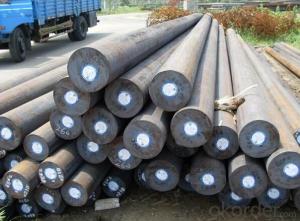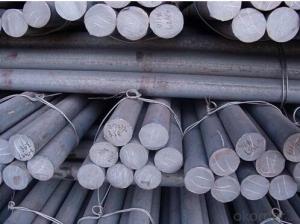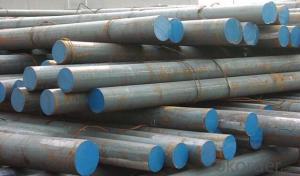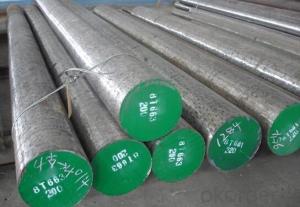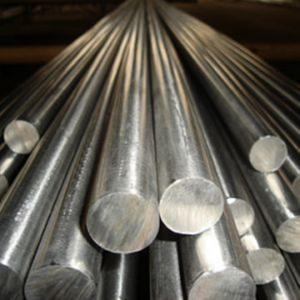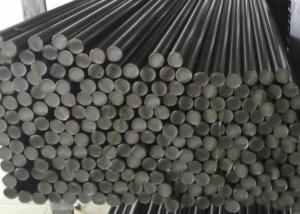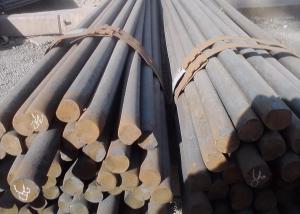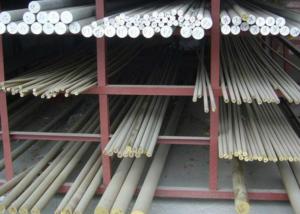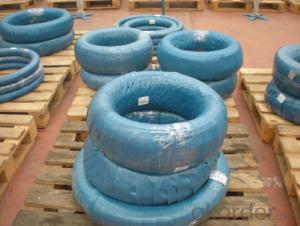Grade 4340 (ASTM A29) Alloy Special Steel Round Bar
- Loading Port:
- Shanghai
- Payment Terms:
- TT OR LC
- Min Order Qty:
- 30 m.t
- Supply Capability:
- 10000 m.t/month
OKorder Service Pledge
OKorder Financial Service
You Might Also Like
Item specifice
Specifications of Round Bar
1. Alloy steel round bar
2. Dia:16mm~250mm
3. Length: 6m, 9m, 12m or as customer’s request
4. Tolerance: Within ±5% for weight; ±2mm for diameter
5. Note: The price can be better is the quantity is good
Equivement Grade
DIN:34CRNIMO
SAE:4340
JIS:SNCM439(SNCM8)
BS:817M40
UNI:40NiCrMo7
Chemical Composition
C | Si | Mn | S | P | Cr | Ni | Cu | Mo |
0.37-0.44 | 0.17-0.37 | 0.50-0.80 | ≤0.025 | ≤0.025 | 0.60-0.90 | 1.25-1.65 | ≤0.025 | 0.15-0.25 |
Our Featured Products
Alloy steel: Combination of steel / Bearing steel// Spring steel/ Cr- mo steel
GB 20Cr/ 40Cr / 42CrMo / 35CrMo/ 20CrMn/GCr15/30CrMnTi…
ASTM 5120 /5140 / 4140/ 4135/ 5152/52100…
JIS SCr420H/ SCr440/ SCM3/ SUP9/SUJ2…
Carbon steel: Carbon tool steel /Carbon Structural Steel
GB 20/ 35 /45/…
ASTM 1020/ 1030/1045…
JIS S20C/ S30C / S45C…
Usage and Applications of Round Bar
1. Chinese standard steel bar is often used where large amounts of steel need to be formed, for example as structural steel.
2. And we can use this kind of product on the performance of the mechanical parts if the demand is not very high.
3. Steel round bar is used in construction and a large number of architectural and engineering structures.
Packaging & Delivery of Round Bar
Packaging Detail: All goods are packed in bundle with steel strips and shipped by break bulk vessel or container (depend on target market and different ports)
Delivery Detail: 15~45 days
Trade terms: FOB, CFR, CIF
MOQ: 30 metric tons per specification; we can negotiate the quantity if the specification is normal or we have stock of one specification.
Weight: Theprice invoicing on theoretical weight basis or actual weight basis depends on customer’s request.
Shipment: The shipment of bulk break or container is depends on customer’s request and the situation of the port of destination.
Documents given: Full set of original clean on board bill of lading; Original signed commercial invoice; Original packing list; Policy of insurance; Certificate of origin and what the target market needs.
Production Flow of Round Bar
1. The common processes are preheated forging quenching, dual refinement solution process, cooling quenching and isothermal quenching. We use heat treatment for dual refinement solution process.
2. Material prepare (billet) — heat up — rough rolling — precision rolling — cooling — packing — storage and transportation
FAQ:
Q1: Why buy Materials & Equipment from OKorder.com?
A1: All products offered byOKorder.com are carefully selected from China's most reliable manufacturing enterprises. Through its ISO certifications, OKorder.com adheres to the highest standards and a commitment to supply chain safety and customer satisfaction.
Q2: How do we guarantee the quality of our products?
A2: We have established an advanced quality management system which conducts strict quality tests at every step, from raw materials to the final product. At the same time, we provide extensive follow-up service assurances as required.
Q3: How soon can we receive the product after purchase?
A3: Within three days of placing an order, we will begin production. The specific shipping date is dependent upon international and government factors, but is typically 7 to 10 workdays.
Q4: What makes stainless steel stainless?
A4: Stainless steel must contain at least 10.5 % chromium. It is this element that reacts with the oxygen in the air to form a complex chrome-oxide surface layer that is invisible but strong enough to prevent further oxygen from "staining" (rusting) the surface. Higher levels of chromium and the addition of other alloying elements such as nickel and molybdenum enhance this surface layer and improve the corrosion resistance of the stainless material.
Q5: Can stainless steel rust?
A5: Stainless does not "rust" as you think of regular steel rusting with a red oxide on the surface that flakes off. If you see red rust it is probably due to some iron particles that have contaminated the surface of the stainless steel and it is these iron particles that are rusting. Look at the source of the rusting and see if you can remove it from the surface.
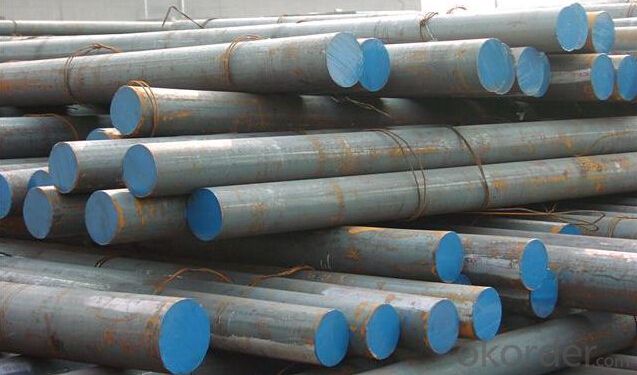
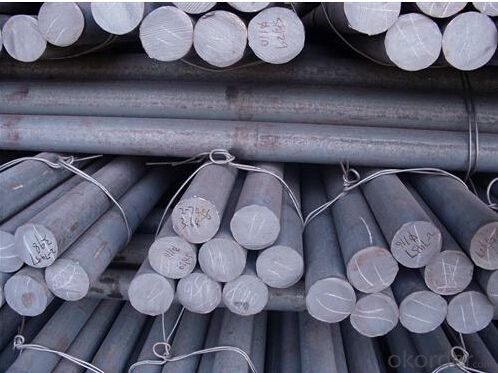
- Q:How does special steel contribute to the manufacturing industry?
- Special steel contributes to the manufacturing industry by providing a versatile and high-quality material for the production of various components and structures. Its exceptional strength, durability, and resistance to corrosion make it ideal for manufacturing machinery, tools, and equipment that require reliability and long lifespan. Additionally, special steel's unique composition allows for precise customization, enabling manufacturers to create complex and intricate designs, meeting the specific needs and requirements of different industries.
- Q:What are the key properties of special steel?
- Special steel has several key properties that set it apart from regular steel. These include high strength, excellent corrosion resistance, good wear resistance, and superior heat resistance. Special steel is also characterized by its ability to withstand extreme temperatures and pressure, making it suitable for critical applications in industries such as aerospace, automotive, and construction. Additionally, special steel can be easily machined and welded, allowing for greater versatility in manufacturing processes.
- Q:What are the safety considerations when handling special steel products?
- When handling special steel products, some important safety considerations include wearing appropriate personal protective equipment (PPE) such as gloves, safety glasses, and steel-toe boots to protect against cuts, burns, and impact injuries. It is also crucial to ensure proper lifting techniques are employed to prevent strains or back injuries. Additionally, storing the steel products in a secure and organized manner can help prevent accidents and injuries. Regular inspections of the equipment and tools used for handling the steel products should be carried out to identify any potential hazards or defects. Lastly, proper training and awareness of the specific safety protocols and procedures related to handling special steel products are essential to minimize risks and maintain a safe working environment.
- Q:How is silicon steel used in electrical transformers?
- Silicon steel is used in electrical transformers as it possesses high magnetic permeability and low electrical conductivity, making it an ideal choice for the core material. The silicon content in the steel increases its resistivity and reduces the energy losses caused by eddy currents. This allows for efficient energy transfer and minimizes heat generation within the transformer.
- Q:What are the safety considerations when working with special steel?
- When working with special steel, there are several safety considerations that need to be taken into account. Firstly, special steel can have high heat resistance, so it is important to use appropriate personal protective equipment (PPE) such as heat-resistant gloves, face shields, and fire-resistant clothing to prevent burns or other heat-related injuries. Secondly, special steel can be heavy and may require the use of lifting equipment or proper lifting techniques to prevent strains or muscle injuries. Additionally, special steel may contain elements or chemicals that could be hazardous if inhaled or ingested, so proper ventilation and respiratory protection should be used. Lastly, the use of sharp tools or equipment is often necessary when working with special steel, so it is crucial to follow safe handling practices and use proper tool guards to prevent cuts or punctures. Overall, awareness of these safety considerations and adherence to safety protocols is essential to ensure a safe working environment when dealing with special steel.
- Q:What are the different heat treatment techniques used for special steel?
- There are several heat treatment techniques used for special steel, including annealing, normalizing, quenching, tempering, and case hardening. Each technique serves a specific purpose in altering the properties of the steel, such as improving hardness, strength, toughness, or ductility. Annealing involves heating the steel to a specific temperature and then slowly cooling it to relieve internal stresses and increase ductility. Normalizing is similar to annealing but involves air cooling instead of slow cooling. Quenching involves rapid cooling of the steel to increase hardness, while tempering is a subsequent heating process to reduce brittleness and enhance toughness. Case hardening involves heating the steel in the presence of a carbon-rich atmosphere to increase surface hardness while maintaining a tough core.
- Q:What are the common heat treatment methods used for special steel?
- Special steel can undergo various heat treatment methods to enhance its mechanical properties and performance. Some commonly used techniques include: 1. Annealing: By heating the steel to a specific temperature and gradually cooling it, internal stresses are relieved and a refined microstructure is formed. This process improves the steel's machinability and ductility. 2. Normalizing: The steel is heated above its critical point and then cooled in still air. This method refines the grain structure, enhances toughness, and improves strength. 3. Quenching: Rapid cooling is achieved by immersing the steel in a quenching medium like water, oil, or polymer. It increases hardness and strength by forming a hard martensitic structure. However, quenching may introduce internal stresses and decrease toughness, so tempering is often performed afterwards. 4. Tempering: Quenched steel is reheated to a specific temperature and gradually cooled. This relieves internal stresses, reduces hardness, and improves toughness and ductility. Tempering also enhances resistance to brittle fracture. 5. Austempering: Steel is quenched to a temperature slightly above its martensitic transformation range, followed by holding it at this temperature until austenite transforms into bainite. This unique microstructure offers a combination of high strength and good toughness. 6. Martempering: Similar to austempering, but the steel is quenched just below its martensitic transformation range and held at that temperature until transformation is complete. Martempering produces a microstructure with improved strength and toughness compared to conventional quenching. These heat treatment methods are widely used to tailor special steel properties according to specific applications and requirements. The choice of method depends on factors such as desired mechanical properties, steel composition, and the intended use of the final product.
- Q:How is shock-resistant alloy steel used in the production of impact-resistant parts?
- Shock-resistant alloy steel is used in the production of impact-resistant parts to enhance their durability and toughness. This type of steel is specifically designed to withstand high impact forces, making it ideal for applications where parts are subjected to intense shock or sudden impact loads. By incorporating shock-resistant alloy steel into the manufacturing process, impact-resistant parts can better absorb and distribute the energy from impacts, thereby reducing the risk of damage or failure.
- Q:Can special steel be used in the telecommunications equipment manufacturing industry?
- Yes, special steel can be used in the telecommunications equipment manufacturing industry. Special steel, known for its exceptional strength, durability, and resistance to corrosion, can be utilized in the production of various telecommunications equipment such as antennas, satellites, transmission towers, and optical fiber cables. Its properties make it ideal for withstanding harsh environmental conditions, ensuring the longevity and reliability of telecommunications infrastructure.
- Q:What are the factors that affect the fatigue strength of special steel?
- There are several factors that can affect the fatigue strength of special steel. These factors include the composition and microstructure of the steel, the presence of impurities or defects, the surface finish and treatment of the steel, the applied stress levels, the temperature and environment in which the steel is used, and the presence of any residual stresses. Additionally, factors such as the frequency and amplitude of cyclic loading, the number of stress cycles, and the presence of any stress concentrations or notches can also impact the fatigue strength of special steel.
1. Manufacturer Overview |
|
|---|---|
| Location | |
| Year Established | |
| Annual Output Value | |
| Main Markets | |
| Company Certifications | |
2. Manufacturer Certificates |
|
|---|---|
| a) Certification Name | |
| Range | |
| Reference | |
| Validity Period | |
3. Manufacturer Capability |
|
|---|---|
| a)Trade Capacity | |
| Nearest Port | |
| Export Percentage | |
| No.of Employees in Trade Department | |
| Language Spoken: | |
| b)Factory Information | |
| Factory Size: | |
| No. of Production Lines | |
| Contract Manufacturing | |
| Product Price Range | |
Send your message to us
Grade 4340 (ASTM A29) Alloy Special Steel Round Bar
- Loading Port:
- Shanghai
- Payment Terms:
- TT OR LC
- Min Order Qty:
- 30 m.t
- Supply Capability:
- 10000 m.t/month
OKorder Service Pledge
OKorder Financial Service
Similar products
New products
Hot products
Related keywords
